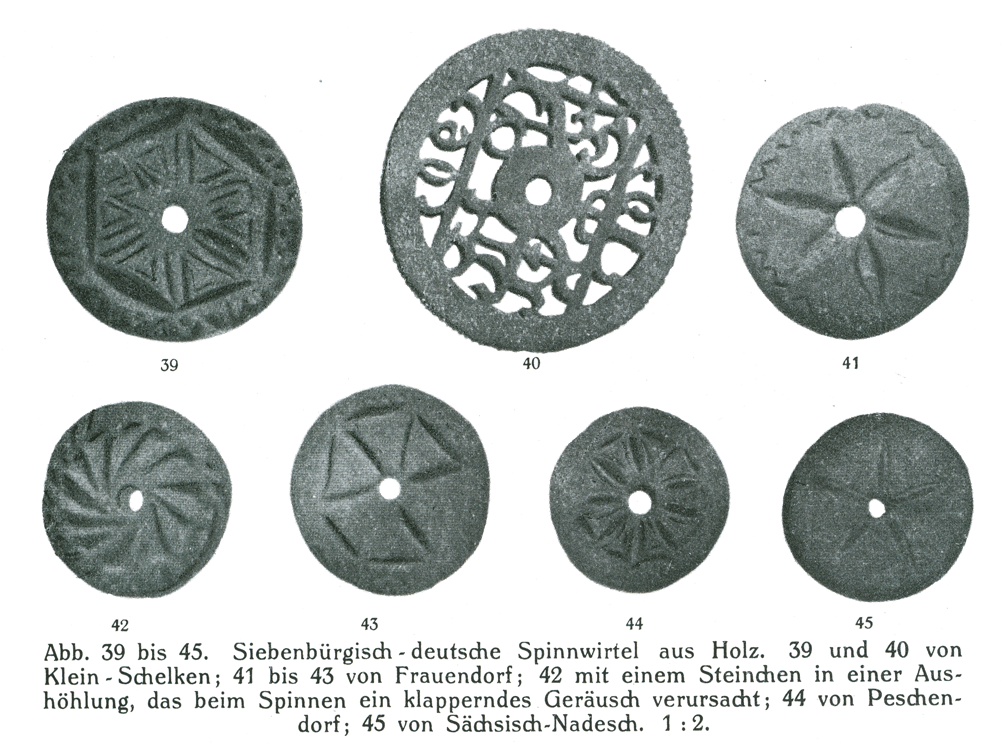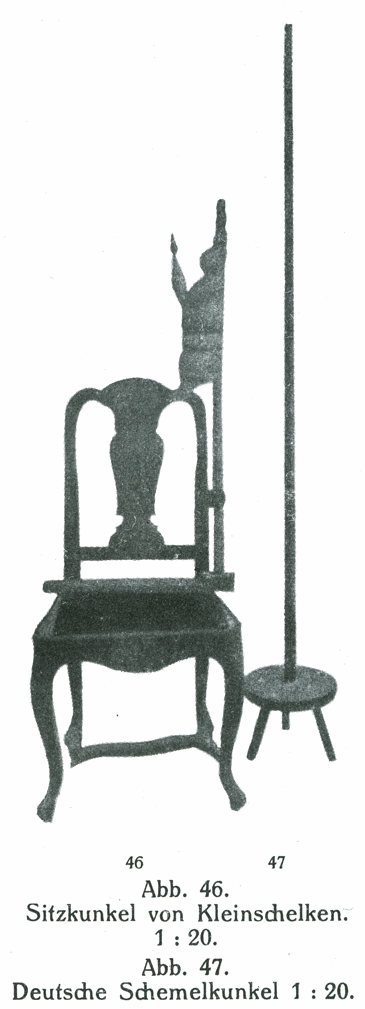Projects and Science
Romania
Europe
ABT
Spinning by the German people of Transylvania
In the 12th century settlers from the German Empire - mainly from the Rhine-Moselle Region – followed the call of the Hungarian king to Transylvania. Today the Transylvanian Saxons are a German-speaking minority in Romania. About 16000 Transylvanian Saxons still live in Transylvania. In Germany today approximately 250000 members of this community can be found, more live in Austria, the USA and Canada. (annotation by the ABT)
The spinning wheel with treadle can be found everywhere, but the old habit of using a hand spindle (späll, spall) could not be displaced completely by the former. Only the women operate the spinning wheel, the girls carry - as in the old times - the simple spindle to the spinning room (rökestuff spanstuff, spännstuff).
The whorls (wierkel, wirtel, wertelchen, wirltche) (Fig. 39 to 45) are used in the same way as the Romanians do and are of similar shape, but the ones decorated with carvings are, in general, not executed a finely as those. I found a curiosity sporadically used in the county Großkokler [Transylvania]. Here, the whorls are sometimes set up in such a way that they produce noise (rattle) during spinning, the reason being that the diligence of the worker can thus be checked at any time.

Here the German stool distaff (binkelröken , stählchenröken , röken) has the greatest distribution. The distaff either has a circular base with three legs (Fig. 47) or a square four-legged base and is almost always painted colorful. In Agnetheln [today: Agnita, Sibiu Region] and its vicinity, in Groß-Schenk [today: Cincu, Braşov Region], Rohrbach [today: Rodbav, Braşov Region]and others and in Klein-Schelken [today: Șeica Mică, Sibiu Region] I found the presumably Wendish1 hook or seat distaff (Fig. 46) in use, the type W. von Schulenburg said to have been in use in the Spreewald in the Lusatia.2
Even among the Germans of Transylvania it is customary for young men to gift the girls with spindle whorls and distaffs, but especially the latter are mostly bought by craftsmen and not made by themselves. Hemp is spun almost exclusively, rarely flax or wool. The fiber (kai , kaier , kotj , zoken , zekelchen) is fastened to the distaff by means of a band (rökeschnäar, reekeschnäar) or an iron chain (rökeneisen).

1Wends (Old English: Winedas, Old Norse: Vindr, German: Wenden, Winden, Danish: Vendere, Swedish: Vender, Polish: Wendowie) is a historical name for West Slavs living near Germanic settlement areas. It does not refer to a homogeneous people, but to various peoples, tribes or groups depending on where and when it is used.
2Lusatia (German: Lausitz, Upper Sorbian: Łužica, Lower Sorbian: Łužyca, Polish: Łużyce, Czech: Lužice) is a historical region in Central Europe. It stretches from the Bóbr and Kwisa rivers in the east to the Elbe valley in the west, today located within the German states of Saxony and Brandenburg as well as in the Lower Silesian and Lubusz voivodeships of western Poland.
(translation by the ABT)
From: Mauritius von Kimakowicz-Winnicki, Spinn- und Webewerkzeuge: Entwicklung und Anwendung in vorgeschichtlicher Zeit Europas. Mannus-Bibliothek 2, Verlag Curt Kabitzsch (Leipzig 1. ed. 1910 / 2. unpubl. ed. 1930), 23-25.